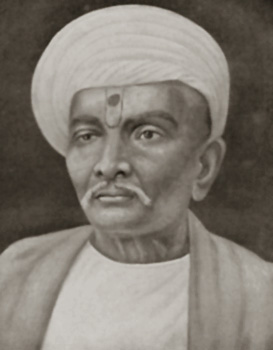 Ven Charit is a Gujarati poem on widow remarriage, written by the poet Dalpatram in 1868. The poem is dedicated to Gopal Krishna Deshmukh, a judge in Ahmedabad`s session`s court. He was among the group of professional Brahmins who initiated the debate on widow remarriage. Deshmukh was closely acquainted with Pune`s leading Chitpavan Brahmins like Moroba who, along with others, started a Vidhavavivahottejak Mandali in 1866. Written in the form of an Akhyan, the poem uses the actual incident of the widowed daughter of Moroba, his consultations with the Shastris and finding Shastric sanctions for the remarriage, and finally the marriage of his daughter Mayabai to a government advocate, a Chitpavan Brahmin, Narayan Bhinde, who was a widower, in Pune in 1866. By placing his narrative in Pune, which was the hotbed of the debates on widow remarriage at that time, Dalpatram brilliantly succeeds in creating a distance from which such issues were viewed in Ahmedabad.
Ven Charit is a Gujarati poem on widow remarriage, written by the poet Dalpatram in 1868. The poem is dedicated to Gopal Krishna Deshmukh, a judge in Ahmedabad`s session`s court. He was among the group of professional Brahmins who initiated the debate on widow remarriage. Deshmukh was closely acquainted with Pune`s leading Chitpavan Brahmins like Moroba who, along with others, started a Vidhavavivahottejak Mandali in 1866. Written in the form of an Akhyan, the poem uses the actual incident of the widowed daughter of Moroba, his consultations with the Shastris and finding Shastric sanctions for the remarriage, and finally the marriage of his daughter Mayabai to a government advocate, a Chitpavan Brahmin, Narayan Bhinde, who was a widower, in Pune in 1866. By placing his narrative in Pune, which was the hotbed of the debates on widow remarriage at that time, Dalpatram brilliantly succeeds in creating a distance from which such issues were viewed in Ahmedabad.
Ven Charit is a long poem of 144 Padas or songs in which Dalpatram discusses at length the question of widow remarriage and the related issues of child marriage, bride price, female infanticide, oppressive wailing on death, remarriage for a childless woman, and women`s education. It narrates the story of the `great` king Ven, acclaimed as a `Raajarshi` even by Manu, who fought tirelessly for widow remarriage and paid with his life for it. Grieved by the plight of the four-year-old widowed daughter of the state priest, Ven the prince pleads with him to get his daughter remarried. When he realises that the Brahmins are against it, he attacks them for being corrupt, argues with them about Shastric sanction for it and tries to convince them of the advantages of remarriage. When the influential and powerful Brahmins refuse to consent, Ven becomes more determined to introduce the practice. As a strategy, he asks the priest to publicly announce the ban for all communities, thus stirring the lower-caste communities that practiced widow remarriage against the Brahmins. The public ban on widow remarriage invokes the anger of the widows of Kanbis and other lower classes who decide to boycott the Brahmins and curse the king. The Brahmins are scared of the material loss they would have to incur if the lower classes stopped production.
In the meanwhile Ven and his mother Sunitha meet Kamala, a child widow who is about to end her life. Ven offers her his wealth and kingdom which she rejects for she says that `without a husband a woman`s life is like a burning fire that destroys her.` Moved by her plight and unable to help her, both Ven and Sunita decide to kill themselves with her when Parashar Muni appears to them and assures them of the Shastric sanctions for widow remarriage found in Parashar Samhita. He also cites examples of Lord Indra and Arjuna having married widows. Reassured by the Rashi`s blessings that widow remarriage is not against the Shastras, Ven takes an oath to implement it against all odds. When the frightened priest informs him of the people`s wrath Ven blames the Brahmins for following Shastras only when it suits them. The Brahmins, frightened that their control over women would go, ask the king to intervene.
At this point enters the king. On the advice of the Brahmins, he stops Ven from implementing the practice, for, he argues, good management of the state involves doing things that are good for the entire community. In a long statement now made, Dalpatram is able to reveal the dominant position of the ruling elite who would not introduce any new practice that would disturb the existing social structure. The rest of the poem describes the more aggressive nature of the conflict and more violent consequences of it. Ven is further propelled to almost kill all the Brahmins while they refuse to relent as they are afraid to lose control. Ven is finally able to get the unfortunate widow Kamla married to a suitable and caring husband. He makes a public announcement giving freedom to all the widows to remarry and introduces legislation, protecting their life and property. When actual changes begin to take place with more widows marrying across castes and the caste barriers breaking down, and with their own position in real danger, the Brahmins retaliate and kill Ven. Ven`s son Pruthuraj, once again complies with the Brahmins, lifts the law, and restores the old order. The poem ends with a celebration of the married life of Kamla and her husband, Navrangi. Dalpatram ends with a final advice to the natives that if they also love their daughters they should send them to school to make them good women.



















